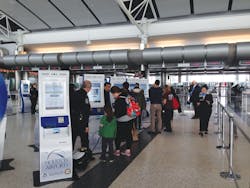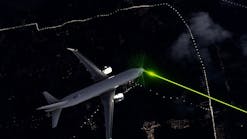Officials at John F. Kennedy International Airport knew they had a problem in international Terminal 4. Customs lines were ever-long and wait times were averaging two hours and sometimes extending up to as many as five.
“Their customs wait times were the worst in the country,” says Steve Sigmund, executive director of the Global Gateway Alliance, an advocacy organization established by CEO Joseph Sitt to address major challenges facing metropolitan airports in New York and New Jersey.
Sadly the scenario at JFK is far from unique. Many gateway airports across the United States experience the same serious delays on a daily basis.
“Bottlenecking at U.S. Immigration has caused long passenger wait times—up to three to four hours at times—as well as costly flight delays and stress on the U.S. Customs and Border Protection (CDP) staff and systems,” says Sean Farrell, head of portfolio management at SITA, an international provider of global information and telecommunications solutions for the air transport industry. He mentions that the situation got so bad at some airports that people waited for hours to get through immigration, and at times had to be kept on the aircraft for an hour or two to wait for the immigration hall to empty out enough for them to enter.
“As a result, international passengers are left with a negative first impression of the United States, discouraging future visits and even potentially impacting regional economic activity supported by tourism and business travel,” Farrell adds.
The negative impact on the nation’s economy is a very real concern. Tourism spending represents big business in the United States. In February, U.S. Secretary of Commerce Penny Pritzker reported that international visitors spent a record-breaking $180.7 billion on U.S. travel and tourism-related goods in 2013. And according to the U.S. Travel Association, this trend adds jobs for U.S. residents; for every 33 overseas travelers coming to the United States, one U.S. job is created.
Yet, in spite of this, a cavalier attitude toward the experiences of international visitors remains. In 2013, a United States Travel Association survey showed that 43 percent of international travelers reported they would not recommend a trip to the United States because of the cumbersome entry process. Data shows these problems will likely escalate as passenger volumes continue to grow. According to IATA, the number of international air travel passengers will reach 1.45 billion by 2016.
Nearly two-thirds of those surveyed by the U.S. Travel Association said alleviating long customs lines would make the United States a more attractive destination. But what is the answer in a time of federal funding shortfalls and shrinking revenues? “The solution to this problem is a combination of technology and manpower,” says Sigmund.
Leverage Technology
According to SITA, Automated Passport Control (APC) self-service kiosks, which allow passengers to provide their travel documents, biometric data and customs declarations prior to speaking with a CBP officer, offer airports a promising solution.
Airports, airlines and the CBP have collaborated to roll out such kiosks in phases. Phase I, which began in May 2013, was open to U.S. citizens only; Phase II expanded eligibility to Canadian citizens in November 2013; while Phase III opened eligibility to visitors from the 37 countries participating in the Visa Waiver Program in January.
The way the kiosks work—for Phase I and II—is instead of presenting a declaration card and their travel documents to a CBP officer, passengers proceed directly to a self-service kiosk to answer the required questions. Once complete, the passengers take a receipt and present it to a CBP official for verification. Phase III kiosks operate a little differently in that they add biometrics scans, such as facial recognition and fingerprint matching, to the customs registration process.
Those airports participating in Phase I and II already report marked improvement since adding the kiosks. Average wait times at JFK’s Terminal 4 were cut in half after installing 40 kiosks in October 2013. While Dallas-Fort Worth International Airport saw similar results after adding kiosks. Before installing this technology, passengers waited more than an hour for customs clearance. “That was just unacceptable to us,” says William Flowers, DFW vice president and chief information officer. “We weren’t in the Top Five that were getting the most news coverage, but we were in the Top 10.”
DFW added 30 kiosks in October 2013 for U.S. and Canadian travelers. “Today our wait times for U.S. and Canadian passengers is basically zero,” Flowers says.
Houston’s George Bush Intercontinental Airport successfully added GCR Inc.’s APC kiosks in January. “It was supposed to be a soft launch, but everything was working so well, the airport director gave us the go-ahead to let all U.S. and Canadian citizens run through on the first day,” says Phillip Brodt, vice president and general manager, GCR. “We did 2,500 passengers that first day and now average more than 5,000 a day.”
Vancouver Airport Authority (YVR) has used kiosks since discovering in 2009 that the border clearance process left a little to be desired. The airport partnered with the Canada Border Services agency to develop its own APC solution, BorderXpress. “This solution allows eligible customers to clear customs four times more quickly while still ensuring the same high standard of safety and security,” says Craig Richmond, president and CEO of the Vancouver Airport Authority.
YVR made its kiosks available to U.S. airports, and to date they have been adopted by Chicago O’Hare and Midway international airports, JFK, and Seattle-Tacoma International Airport. “In the first 40 days of operation, Chicago O’Hare’s kiosk users took only four minutes to pass through customs, while non-kiosk users spent 38 minutes,” says Richmond. “Peak wait times there were reduced by 33 percent for all passengers.”
How can a simple kiosk lead to shorter wait times? Easy. When DFW considered adding kiosks, they examined the process, looked at how things were segregated between international and domestic passengers, reviewed the Global Entry program, and then looked at their hall to develop a solution. They decided to create 10 rows equipped with three kiosks each. “Passengers walk in, spot an open area, and use the kiosk, which prevents people from building a queue,” says Flowers. “We made sure it was open-ended so that people could just walk up to an available machine. That was a major, major change because it’s just human nature for people to get into a queue and wait for the next person to move.”
SITA’s Farrell underscores the importance of this change by saying: “If it took 60 seconds to capture data on an immigration lane that caused a bottleneck. But if you put 20 kiosks in front of five immigration lanes, you can speed up the process by four times, because you have four times as many kiosks as you had immigration lanes.”
The kiosk’s intuitive nature simplifies processing to save time. The kiosks also allow group travelers to process at the same time, so families traveling together can use one kiosk to scan their documents, answer declaration questions and confirm their flight information.
“From a processing perspective, a single person can get through a kiosk in 20 to 40 seconds,” says Flowers, noting a family can get through in less than three minutes.
Finetune Visa Waiver Screening
Phase II offers the greatest potential benefits, according to Farrell.
“The processing of foreign visitors takes a long time because visitors are required to provide fingerprint and facial biometrics,” he says. “Airports that leverage Phase III APC kiosks, rather than relying out the outdated capabilities offered through Phase I or II kiosks, will benefit from much higher passenger throughput at immigration. That will significantly reduce the wait times for all travelers and improve the overall travel experience.”
Orlando International Airport recently became one of the first airports to tackle Phase III screening with SITA’s kiosk technology. According to Farrell, it made sense to implement it here, because Orlando, Fla., is a popular destination for international travelers. “In an airport like Orlando, where a lot of their traffic is vacationers and families, the last thing they want is for their first impression to be that you arrive at the airport and then have to wait in line for hours to get through immigration,” he says.
International passengers, particularly those from Visa Waiver countries, have a specific set of customs entry requirements. They must provide fingerprints and facial biometrics in addition to travel documents and customs declarations.
“There are about 30 different countries where you are not required to get a visa, but you are not a U.S. citizen or resident,” says Farrell. “These individuals have to provide fingerprint as well as facial data, and they take more time to process at the immigration line. Rolling out Phase III kiosks offloads the worst part of the immigration process to these kiosks.”
According to Farrell, once a passenger places his passport on SITA’s Phase III reader, the entire upper half of the kiosk automatically raises or lowers using eye-finding technology so that the face camera, fingerprint reader and other devices are located at the most ergonomic position to ensure fast and high-quality biometric capture. Lighting surrounding the face camera adapts to current airport conditions to ensure the face is evenly lit as the system captures the image.
The kiosks automatically submit all of this data to the U.S. government, where officials check it against various databases. “All of their information is vetted to match you to the manifest, make sure you’re not on the no-fly list, there are no alias issues with your name, and that sort of thing,” says GCR’s Brodt, whose firm has also developed a Phase III kiosk.
After this screening, a receipt prints for the traveler with a barcode on it. The barcode contains information as to whether or not this passenger is good to go through customs. “In the vast majority of cases, they are just waived through based on the information on that receipt,” he says. “The process takes around 90 seconds to complete which is far faster than before.”
Better Managed Manpower
In a letter dated, April 9, board members of the Global Gateway Alliance tasked U.S. Customs and Border Protection Richard Gil Kerlikowske with doing more to address the problem. The letter praises the organization for its recent attention to the issue, mentioning that APC kiosks were making a difference industry-wide. It also praised the Obama Administration Fiscal Year 2015 budget proposal to add 2,000 additional CBP agents at airports nationwide.
However, the letter cautions the issue is far from resolved.
“The advancements are a good start, but it is no means times for a victory lap,” reads the letter. “We have a long way to go for our airports, airlines and most importantly millions of international passengers. In order to continue to improve the situation, the CBP and the aviation industry must take aggressive productive steps to expand their efforts.”
The Global Gateway Alliance letter calls on CBP to stop the practice of deploying officers to pre-clearance airports without significant domestic air carrier presence and passenger traffic to the United States. The letter points out that Abu Dhabi sends an average of 573 passengers a day to the United State and U.S. airlines do not serve the airport, yet CBP has opened a pre-clearance facility there.
“Our view is that given the significant problems we’re facing with long customs lines here, the agency’s staffing and resources need to be focused in the United States first,” Sigmund says.
The letter also demanded that CBP coordinate better with airlines to deploy officers when and where they are most needed, expand technology applications in the customs hall, and adopt new management practices.
“We believe manpower needs to be deployed in better ways,” says Sigmund, explaining that airports currently CBP agents to specific terminals, but the Global Gateway Alliance believes these agents would be more effective if they rotated between terminals based on need. “Agents also should not be doing administrative tasks; they should be able to use part-time employees to do that,” he says.
Though it’s clear there is more work to be done, technology has already started CBP on the road to making bottlenecks in the customs hall a thing of the past.


